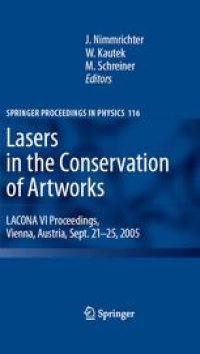
Ebook: Lasers in the Conservation of Artworks: LACONA VI Proceedings, Vienna, Austria, Sept. 21–25, 2005
- Tags: Laser Technology and Physics Photonics, Physics and Applied Physics in Engineering
- Series: Springer proceedings in physics 116
- Year: 2007
- Publisher: Springer-Verlag Berlin Heidelberg
- Edition: 1
- Language: English
- pdf
Within the last decades, the use of lasers in artworks conservation became an important tool for many conservators, scientists, architects and other experts, who are involved in the care of monuments and artefacts or laser technology. For the first time in 1995 Professor Costas Fotakis brought together restorers and scientists to discuss the potential of lasers in art conservation. Since then the field of "Lasers in the Conservation of Artworks" has gained enormously in importance. Nowadays restorers and laser scientists work close together in order to develop new fields of applications during the last years. Furthermore a large number of national and international research projects have been carried out by conservator-restorers, architects and scientists. In the last 10 years a number of historical and artistic high quality monuments (e.g. St. Stephens Cathedral in Vienna) have been cleaned or measured by laser and brought the laser in the spectra of tools which are useful in the sensible field of artworks. The proceedings of the congress addresses scientists, conservator-restorers, companies, architects, decision-makers and other experts involved in conservation projects or in the research of new laser equipment.
Within the last decades, the use of lasers in artworks conservation became an important tool for many conservators, scientists, architects and other experts, who are involved in the care of monuments and artefacts or laser technology. For the first time in 1995 Professor Costas Fotakis brought together restorers and scientists to discuss the potential of lasers in art conservation. Since then the field of "Lasers in the Conservation of Artworks" has gained enormously in importance. Nowadays restorers and laser scientists work close together in order to develop new fields of applications during the last years. Furthermore a large number of national and international research projects have been carried out by conservator-restorers, architects and scientists. In the last 10 years a number of historical and artistic high quality monuments (e.g. St. Stephens Cathedral in Vienna) have been cleaned or measured by laser and brought the laser in the spectra of tools which are useful in the sensible field of artworks. The proceedings of the congress addresses scientists, conservator-restorers, companies, architects, decision-makers and other experts involved in conservation projects or in the research of new laser equipment.